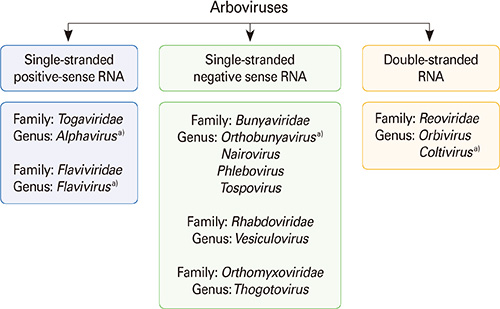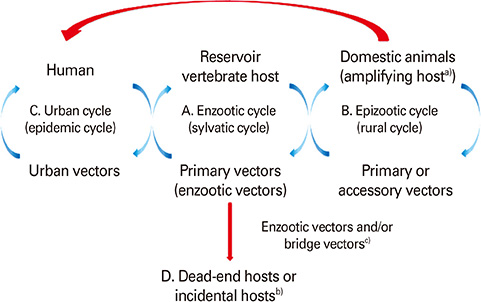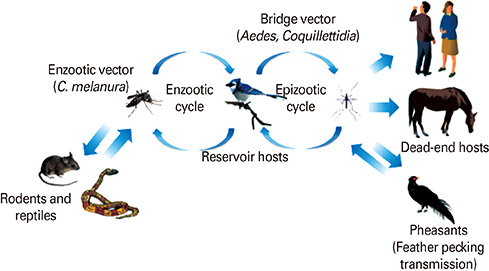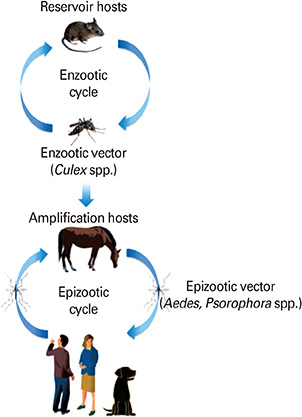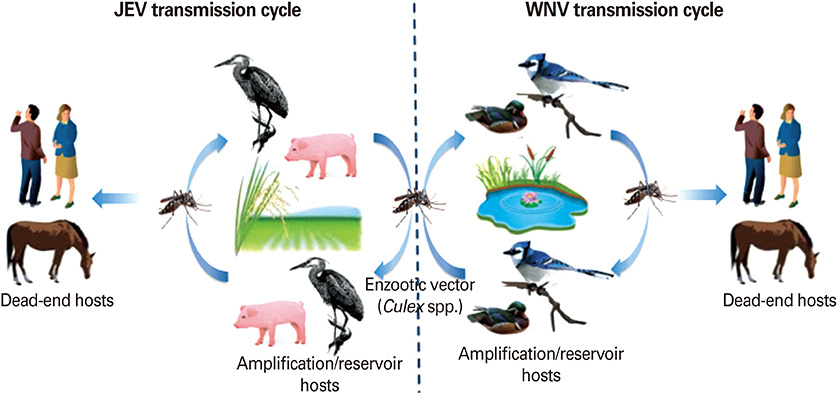Clin Exp Vaccine Res.
2014 Jan;3(1):58-77. 10.7774/cevr.2014.3.1.58.
Zoonotic encephalitides caused by arboviruses: transmission and epidemiology of alphaviruses and flaviviruses
- Affiliations
-
- 1Virus Research and Testing Group, Division of Drug Discovery Research, Korea Research Institute of Chemical Technology, Daejeon, Korea. yygo@krict.re.kr
- 2Maxwell H. Gluck Equine Research Center, Department of Veterinary Science, College of Agriculture, Food and Environment, University of Kentucky, Lexington, KY, USA.
- 3Department of Microbiology, Immunology and Molecular Genetics, College of Medicine, University of Kentucky, Lexington, KY, USA.
- KMID: 2049097
- DOI: http://doi.org/10.7774/cevr.2014.3.1.58
Abstract
- In this review, we mainly focus on zoonotic encephalitides caused by arthropod-borne viruses (arboviruses) of the families Flaviviridae (genus Flavivirus) and Togaviridae (genus Alphavirus) that are important in both humans and domestic animals. Specifically, we will focus on alphaviruses (Eastern equine encephalitis virus, Western equine encephalitis virus, Venezuelan equine encephalitis virus) and flaviviruses (Japanese encephalitis virus and West Nile virus). Most of these viruses were originally found in tropical regions such as Africa and South America or in some regions in Asia. However, they have dispersed widely and currently cause diseases around the world. Global warming, increasing urbanization and population size in tropical regions, faster transportation and rapid spread of arthropod vectors contribute in continuous spreading of arboviruses into new geographic areas causing reemerging or resurging diseases. Most of the reemerging arboviruses also have emerged as zoonotic disease agents and created major public health issues and disease epidemics.
Keyword
MeSH Terms
-
Africa
Alphavirus*
Animals, Domestic
Arboviruses*
Arthropod Vectors
Asia
Encephalitis
Encephalitis Virus, Venezuelan Equine
Encephalitis Virus, Western Equine
Encephalitis Viruses
Encephalomyelitis, Equine
Epidemiology*
Flaviviridae
Flavivirus*
Global Warming
Humans
Population Density
Public Health
South America
Togaviridae
Transportation
Urbanization
Zoonoses
Figure
Cited by 2 articles
-
Recharacterization of Morphological and Genetic Feature of Getah Virus Isolated from South Korea
Seung Heon Lee, Dong-Kun Yang, Ha-Hyun Kim, Hyun-Ye Jo, Sung-Suk Choi, Jung-Won Park, Kang-Seuk Choi, In-Soo Cho
J Bacteriol Virol. 2015;45(4):328-338. doi: 10.4167/jbv.2015.45.4.328.Development and Evaluation of Indirect ELISA for Detection of Antibodies to Getah Virus in Horse Serum
Seung Heon Lee, Dong-Kun Yang, Ha-Hyun Kim, Hyun-Ye Jo, Sung-Suk Choi, In-Soo Cho
J Bacteriol Virol. 2016;46(2):63-77. doi: 10.4167/jbv.2016.46.2.63.
Reference
-
1. JOINT WHO/FAO expert committee on zoonoses. World Health Organ Tech Rep Ser. 1959; 58:1–84.2. Hollidge BS, Gonzalez-Scarano F, Soldan SS. Arboviral encephalitides: transmission, emergence, and pathogenesis. J Neuroimmune Pharmacol. 2010; 5:428–442.
Article3. Soldan SS, Gonzalez-Scarano F. Emerging infectious diseases: the Bunyaviridae. J Neurovirol. 2005; 11:412–423.4. Elliott R. Bunyaviruses: general features. In : Mahy BW, van Regenmortel MH, editors. Encyclopedia of virology. . London: Elsevier-Academic Press;2008. p. 390–399.5. Calisher CH. Medically important arboviruses of the United States and Canada. Clin Microbiol Rev. 1994; 7:89–116.
Article6. Gunther G, Haglund M. Tick-borne encephalopathies: epidemiology, diagnosis, treatment and prevention. CNS Drugs. 2005; 19:1009–1032.7. Romero JR, Simonsen KA. Powassan encephalitis and Colorado tick fever. Infect Dis Clin North Am. 2008; 22:545–559.
Article8. Miller BR, Nasci RS, Godsey MS, et al. First field evidence for natural vertical transmission of West Nile virus in Culex univittatus complex mosquitoes from Rift Valley province, Kenya. Am J Trop Med Hyg. 2000; 62:240–246.
Article9. Rosen L. Further observations on the mechanism of vertical transmission of flaviviruses by Aedes mosquitoes. Am J Trop Med Hyg. 1988; 39:123–126.
Article10. Pfeffer M, Dobler G. Emergence of zoonotic arboviruses by animal trade and migration. Parasit Vectors. 2010; 3:35.
Article11. Watts DM, Thompson WH, Yuill TM, DeFoliart GR, Hanson RP. Overwintering of La Crosse virus in Aedes triseriatus. Am J Trop Med Hyg. 1974; 23:694–700.12. Gubler DJ. The global resurgence of arboviral diseases. Trans R Soc Trop Med Hyg. 1996; 90:449–451.
Article13. Hanna JN, Ritchie SA, Phillips DA, et al. Japanese encephalitis in north Queensland, Australia, 1998. Med J Aust. 1999; 170:533–536.
Article14. Hanna JN, Ritchie SA, Phillips DA, et al. An outbreak of Japanese encephalitis in the Torres Strait, Australia, 1995. Med J Aust. 1996; 165:256–260.
Article15. Dobler G. Arboviruses causing neurological disorders in the central nervous system. Arch Virol Suppl. 1996; 11:33–40.
Article16. Gubler DJ. Human arbovirus infections worldwide. Ann N Y Acad Sci. 2001; 951:13–24.
Article17. Weaver SC, Barrett AD. Transmission cycles, host range, evolution and emergence of arboviral disease. Nat Rev Microbiol. 2004; 2:789–801.
Article18. Kuhn RJ. Togaviridae: the viruses and their replication. In : Knipe DM, Howley PM, editors. Fields virology. Philadelphia: Lippincott Williams & Wilkins;2012. p. 629–650.19. Strauss EG, Rice CM, Strauss JH. Complete nucleotide sequence of the genomic RNA of Sindbis virus. Virology. 1984; 133:92–110.
Article20. Simmons DT, Strauss JH. Replication of Sindbis virus. I. Relative size and genetic content of 26S and 49S RNA. J Mol Biol. 1972; 71:599–613.
Article21. Powers AM, Brault AC, Shirako Y, et al. Evolutionary relationships and systematics of the alphaviruses. J Virol. 2001; 75:10118–10131.
Article22. Strauss JH, Strauss EG. The alphaviruses: gene expression, replication, and evolution. Microbiol Rev. 1994; 58:491–562.
Article23. La Linn M, Gardner J, Warrilow D, et al. Arbovirus of marine mammals: a new alphavirus isolated from the elephant seal louse, Lepidophthirus macrorhini. J Virol. 2001; 75:4103–4109.
Article24. Travassos da Rosa AP, Turell MJ, Watts DM, et al. Trocara virus: a newly recognized Alphavirus (Togaviridae) isolated from mosquitoes in the Amazon Basin. Am J Trop Med Hyg. 2001; 64:93–97.
Article25. Zacks MA, Paessler S. Encephalitic alphaviruses. Vet Microbiol. 2010; 140:281–286.
Article26. Krauss H, Weber A, Appel M, et al. Zoonoses: infectious diseases transmissible from animals to humans. Washington: ASM Press;2003.27. Scott TW, Weaver SC. Eastern equine encephalomyelitis virus: epidemiology and evolution of mosquito transmission. Adv Virus Res. 1989; 37:277–328.
Article28. Hanson RP. An epizootic of equine encephalomyelitis that occurred in Massachusetts in 1831. Am J Trop Med Hyg. 1957; 6:858–862.
Article29. Sabattini MS, Monath TP, Mitchell CJ, et al. Arbovirus investigations in Argentina, 1977-1980. I. Historical aspects and description of study sites. Am J Trop Med Hyg. 1985; 34:937–944.30. Weaver SC, Winegar R, Manger ID, Forrester NL. Alphaviruses: population genetics and determinants of emergence. Antiviral Res. 2012; 94:242–257.
Article31. Aguilar PV, Paessler S, Carrara AS, et al. Variation in interferon sensitivity and induction among strains of eastern equine encephalitis virus. J Virol. 2005; 79:11300–11310.
Article32. Aguilar PV, Robich RM, Turell MJ, et al. Endemic eastern equine encephalitis in the Amazon region of Peru. Am J Trop Med Hyg. 2007; 76:293–298.
Article33. Weaver SC, Powers AM, Brault AC, Barrett AD. Molecular epidemiological studies of veterinary arboviral encephalitides. Vet J. 1999; 157:123–138.
Article34. Brault AC, Powers AM, Chavez CL, et al. Genetic and antigenic diversity among eastern equine encephalitis viruses from North, Central, and South America. Am J Trop Med Hyg. 1999; 61:579–586.
Article35. Weaver SC, Vasilakis N. Molecular evolution of dengue viruses: contributions of phylogenetics to understanding the history and epidemiology of the preeminent arboviral disease. Infect Genet Evol. 2009; 9:523–540.
Article36. Chang GJ, Trent DW. Nucleotide sequence of the genome region encoding the 26S mRNA of eastern equine encephalomyelitis virus and the deduced amino acid sequence of the viral structural proteins. J Gen Virol. 1987; 68(Pt 8):2129–2142.
Article37. Gibney KB, Robinson S, Mutebi JP, et al. Eastern equine encephalitis: an emerging arboviral disease threat, Maine, 2009. Vector Borne Zoonotic Dis. 2011; 11:637–639.
Article38. Arrigo NC, Adams AP, Weaver SC. Evolutionary patterns of eastern equine encephalitis virus in North versus South America suggest ecological differences and taxonomic revision. J Virol. 2010; 84:1014–1025.
Article39. Deresiewicz RL, Thaler SJ, Hsu L, Zamani AA. Clinical and neuroradiographic manifestations of eastern equine encephalitis. N Engl J Med. 1997; 336:1867–1874.
Article40. Causey OR, Causey CE, Maroja OM, Macedo DG. The isolation of arthropod-borne viruses, including members of two hitherto undescribed serological groups, in the Amazon region of Brazil. Am J Trop Med Hyg. 1961; 10:227–249.
Article41. Corniou B, Ardoin P, Bartholomew C, Ince W, Massiah V. First isolation of a South American strain of Eastern Equine virus from a case of encephalitis in Trinidad. Trop Geogr Med. 1972; 24:162–167.42. Sabattini MS, Daffner JF, Monath TP, et al. Localized eastern equine encephalitis in Santiago del Estero Province, Argentina, without human infection. . Medicina (B Aires). 1991; 51:3–8.43. Aguilar PV, Greene IP, Coffey LL, et al. Endemic Venezuelan equine encephalitis in northern Peru. Emerg Infect Dis. 2004; 10:880–888.
Article44. Monath TP, Sabattini MS, Pauli R, et al. Arbovirus investigations in Argentina, 1977-1980. IV. Serologic surveys and sentinel equine program. Am J Trop Med Hyg. 1985; 34:966–975.45. Armstrong PM, Andreadis TG. Eastern equine encephalitis virus in mosquitoes and their role as bridge vectors. Emerg Infect Dis. 2010; 16:1869–1874.
Article46. Molaei G, Oliver J, Andreadis TG, Armstrong PM, Howard JJ. Molecular identification of blood-meal sources in Culiseta melanura and Culiseta morsitans from an endemic focus of eastern equine encephalitis virus in New York. Am J Trop Med Hyg. 2006; 75:1140–1147.
Article47. Estep LK, McClure CJ, Burkett-Cadena ND, et al. A multi-year study of mosquito feeding patterns on avian hosts in a southeastern focus of eastern equine encephalitis virus. Am J Trop Med Hyg. 2011; 84:718–726.
Article48. Bingham AM, Graham SP, Burkett-Cadena ND, White GS, Hassan HK, Unnasch TR. Detection of eastern equine encephalomyelitis virus RNA in North American snakes. Am J Trop Med Hyg. 2012; 87:1140–1144.
Article49. Graham SP, Hassan HK, Chapman T, White G, Guyer C, Unnasch TR. Serosurveillance of eastern equine encephalitis virus in amphibians and reptiles from Alabama, USA. Am J Trop Med Hyg. 2012; 86:540–544.
Article50. White G, Ottendorfer C, Graham S, Unnasch TR. Competency of reptiles and amphibians for eastern equine encephalitis virus. Am J Trop Med Hyg. 2011; 85:421–425.
Article51. Day JF, Stark LM. Eastern equine encephalitis transmission to emus (Dromaius novaehollandiae) in Volusia County, Florida: 1992 through 1994. J Am Mosq Control Assoc. 1996; 12(3 Pt 1):429–436.52. Fothergill LD, Dingle JH, Fellow JJ. A fatal disease of pigeons caused by the virus of the eastern variety of equine encephalomyelitis. Science. 1938; 88:549–550.
Article53. Guy JS, Ficken MD, Barnes HJ, Wages DP, Smith LG. Experimental infection of young turkeys with eastern equine encephalitis virus and highlands J virus. Avian Dis. 1993; 37:389–395.
Article54. Luginbuhl RE, Satriano SF, Helmboldt CF, Lamson AL, Jungherr EL. Investigation of eastern equine encephalomyelitis. II. Outbreaks in Connecticut pheasants. Am J Hyg. 1958; 67:4–9.55. Satriano SF, Luginbuhl RE, Wallis RC, Jungherr EL, Williamson LA. Investigation of eastern equine encephalomyelitis. IV. Susceptibility and transmission studies with virus of pheasant origin. Am J Hyg. 1958; 67:21–34.56. Arrigo NC, Adams AP, Watts DM, Newman PC, Weaver SC. Cotton rats and house sparrows as hosts for North and South American strains of eastern equine encephalitis virus. Emerg Infect Dis. 2010; 16:1373–1380.
Article57. Bauer RW, Gill MS, Poston RP, Kim DY. Naturally occurring eastern equine encephalitis in a Hampshire wether. J Vet Diagn Invest. 2005; 17:281–285.
Article58. Tate CM, Howerth EW, Stallknecht DE, Allison AB, Fischer JR, Mead DG. Eastern equine encephalitis in a free-ranging white-tailed deer (Odocoileus virginianus). J Wildl Dis. 2005; 41:241–245.
Article59. Farrar MD, Miller DL, Baldwin CA, Stiver SL, Hall CL. Eastern equine encephalitis in dogs. J Vet Diagn Invest. 2005; 17:614–617.
Article60. Freier JE. Eastern equine encephalomyelitis. Lancet. 1993; 342:1281–1282.
Article61. McGee ED, Littleton CH, Mapp JB, Brown RJ. Eastern equine encephalomyelitis in an adult cow. Vet Pathol. 1992; 29:361–363.
Article62. Walder R, Suarez OM, Calisher CH. Arbovirus studies in southwestern Venezuela during 1973-1981. II. Isolations and further studies of Venezuelan and eastern equine encephalitis, Una, Itaqui, and Moju viruses. Am J Trop Med Hyg. 1984; 33:483–491.63. Strizki JM, Repik PM. Differential reactivity of immune sera from human vaccinees with field strains of eastern equine encephalitis virus. Am J Trop Med Hyg. 1995; 53:564–570.
Article64. Hahn CS, Lustig S, Strauss EG, Strauss JH. Western equine encephalitis virus is a recombinant virus. Proc Natl Acad Sci U S A. 1988; 85:5997–6001.
Article65. Weaver SC, Kang W, Shirako Y, Rumenapf T, Strauss EG, Strauss JH. Recombinational history and molecular evolution of western equine encephalomyelitis complex alphaviruses. J Virol. 1997; 71:613–623.
Article66. Meyer KF, Haring CM, Howitt B. The etiology of epizootic encephalomyelitis of horses in the San Joaquin Valley, 1930. Science. 1931; 74:227–228.
Article67. Howitt B. Recovery of the virus of equine encephalomyelitis from the brain of a child. Science. 1938; 88:455–456.
Article68. Reisen WK, Chiles RE. Prevalence of antibodies to western equine encephalomyelitis and St. Louis encephalitis viruses in residents of California exposed to sporadic and consistent enzootic transmission. Am J Trop Med Hyg. 1997; 57:526–529.
Article69. Reisen WK, Hardy JL, Lothrop HD. Landscape ecology of arboviruses in southern California: patterns in the epizootic dissemination of western equine encephalomyelitis and St. Louis encephalitis viruses in Coachella Valley, 1991-1992. J Med Entomol. 1995; 32:267–275.
Article70. Reimann CA, Hayes EB, DiGuiseppi C, et al. Epidemiology of neuroinvasive arboviral disease in the United States, 1999-2007. Am J Trop Med Hyg. 2008; 79:974–979.
Article71. Longshore WA Jr, Stevens IM, Hollister AC Jr, Gittelsohn A, Lennette EH. Epidemiologic observations on acute infectious encephalitis in California, with special reference to the 1952 outbreak. Am J Hyg. 1956; 63:69–86.
Article72. Doby PB, Schnurrenberger PR, Martin RJ, Hanson LE, Sherrick GW, Schoenholz WK. Western encephalitis in Illinois horses and ponies. J Am Vet Med Assoc. 1966; 148:422–427.73. Jennings WL, Allen RH, Lewis AL. Western equine encephalomyelitis in a Florida horse. Am J Trop Med Hyg. 1966; 15:96–97.74. Karabatsos N, Lewis AL, Calisher CH, Hunt AR, Roehrig JT. Identification of Highlands J virus from a Florida horse. Am J Trop Med Hyg. 1988; 39:603–606.
Article75. Ficken MD, Wages DP, Guy JS, Quinn JA, Emory WH. High mortality of domestic turkeys associated with Highlands J virus and eastern equine encephalitis virus infections. Avian Dis. 1993; 37:585–590.
Article76. Guy JS, Barnes HJ, Ficken MD, Smith LG, Emory WH, Wages DP. Decreased egg production in turkeys experimentally infected with eastern equine encephalitis virus or Highlands J virus. Avian Dis. 1994; 38:563–571.
Article77. Guy JS, Barnes HJ, Smith LG. Experimental infection of young broiler chickens with eastern equine encephalitis virus and Highlands J virus. Avian Dis. 1994; 38:572–582.
Article78. Wages DP, Ficken MD, Guy JS, Cummings TS, Jennings SR. Egg-production drop in turkeys associated with alphaviruses: eastern equine encephalitis virus and Highlands J virus. Avian Dis. 1993; 37:1163–1166.
Article79. Reisen WK, Monath TP. Western equine encephalomyelitis. In : Monath TP, editor. The arboviruses: epidemiology and ecology. Boca Raton: CRC Press;1988. p. 89–138.80. Calisher CH, Karabatsos N, Lazuick JS, Monath TP, Wolff KL. Reevaluation of the western equine encephalitis antigenic complex of alphaviruses (family Togaviridae) as determined by neutralization tests. Am J Trop Med Hyg. 1988; 38:447–452.
Article81. Fulhorst CF, Hardy JL, Eldridge BF, Presser SB, Reeves WC. Natural vertical transmission of western equine encephalomyelitis virus in mosquitoes. Science. 1994; 263:676–678.
Article82. Pittman P, Plotkin SA. Biodefense and special pathogen vaccines. In : Plotkin SA, Orenstein WA, Offit PA, editors. Vaccines. Philadelphia: Elsevier;2008. p. 1123–1133.83. Barber TL, Walton TE, Lewis KJ. Efficacy of trivalent inactivated encephalomyelitis virus vaccine in horses. Am J Vet Res. 1978; 39:621–625.84. Dickerman RW, Cupp EW, Groot H, et al. Venezuelan equine encephalitis virus activity in northern Colombia during April and May 1983. Bull Pan Am Health Organ. 1986; 20:276–283.85. Estrada-Franco JG, Navarro-Lopez R, Freier JE, et al. Venezuelan equine encephalitis virus, southern Mexico. Emerg Infect Dis. 2004; 10:2113–2121.
Article86. Oberste MS, Schmura SM, Weaver SC, Smith JF. Geographic distribution of Venezuelan equine encephalitis virus subtype IE genotypes in Central America and Mexico. Am J Trop Med Hyg. 1999; 60:630–634.
Article87. Quiroz E, Aguilar PV, Cisneros J, Tesh RB, Weaver SC. Venezuelan equine encephalitis in Panama: fatal endemic disease and genetic diversity of etiologic viral strains. PLoS Negl Trop Dis. 2009; 3:e472.
Article88. Weaver SC, Ferro C, Barrera R, Boshell J, Navarro JC. Venezuelan equine encephalitis. Annu Rev Entomol. 2004; 49:141–174.
Article89. Weaver SC, Pfeffer M, Marriott K, Kang W, Kinney RM. Genetic evidence for the origins of Venezuelan equine encephalitis virus subtype IAB outbreaks. Am J Trop Med Hyg. 1999; 60:441–448.
Article90. Sneider JM, Kinney RM, Tsuchiya KR, Trent DW. Molecular evidence that epizootic Venezuelan equine encephalitis (VEE) I-AB viruses are not evolutionary derivatives of enzootic VEE subtype I-E or II viruses. J Gen Virol. 1993; 74(Pt 3):519–523.
Article91. Zehmer RB, Dean PB, Sudia WD, Calisher CH, Sather GE, Parker RL. Venezuelan equine encephalitis epidemic in Texas, 1971. Health Serv Rep. 1974; 89:278–282.
Article92. Beck CE, Wyckoff RW. Venezuelan equine encephalomyelitis. Science. 1938; 88:530.
Article93. Kinney RM, Trent DW, France JK. Comparative immunological and biochemical analyses of viruses in the Venezuelan equine encephalitis complex. J Gen Virol. 1983; 64(Pt 1):135–147.
Article94. Young NA, Johnson KM. Antigenic variants of Venezuelan equine encephalitis virus: their geographic distribution and epidemiologic significance. Am J Epidemiol. 1969; 89:286–307.95. Brault AC, Powers AM, Holmes EC, Woelk CH, Weaver SC. Positively charged amino acid substitutions in the e2 envelope glycoprotein are associated with the emergence of Venezuelan equine encephalitis virus. J Virol. 2002; 76:1718–1730.
Article96. Brault AC, Powers AM, Weaver SC. Vector infection determinants of Venezuelan equine encephalitis virus reside within the E2 envelope glycoprotein. J Virol. 2002; 76:6387–6392.
Article97. Adams AP, Navarro-Lopez R, Ramirez-Aguilar FJ, et al. Venezuelan equine encephalitis virus activity in the Gulf Coast region of Mexico, 2003-2010. PLoS Negl Trop Dis. 2012; 6:e1875.
Article98. Deardorff ER, Weaver SC. Vector competence of Culex (Melanoconion) taeniopus for equine-virulent subtype IE strains of Venezuelan equine encephalitis virus. Am J Trop Med Hyg. 2010; 82:1047–1052.
Article99. Powers AM, Oberste MS, Brault AC, et al. Repeated emergence of epidemic/epizootic Venezuelan equine encephalitis from a single genotype of enzootic subtype ID virus. J Virol. 1997; 71:6697–6705.
Article100. Aguilar PV, Adams AP, Suarez V, et al. Genetic characterization of Venezuelan equine encephalitis virus from Bolivia, Ecuador and Peru: identification of a new subtype ID lineage. PLoS Negl Trop Dis. 2009; 3:e514.
Article101. Johnson KM, Martin DH. Venezuelan equine encephalitis. Adv Vet Sci Comp Med. 1974; 18:79–116.102. Rivas F, Diaz LA, Cardenas VM, et al. Epidemic Venezuelan equine encephalitis in La Guajira, Colombia, 1995. J Infect Dis. 1997; 175:828–832.
Article103. Weaver SC, Salas R, Rico-Hesse R, et al. VEE Study Group. Re-emergence of epidemic Venezuelan equine encephalomyelitis in South America. Lancet. 1996; 348:436–440.
Article104. Aguilar PV, Estrada-Franco JG, Navarro-Lopez R, Ferro C, Haddow AD, Weaver SC. Endemic Venezuelan equine encephalitis in the Americas: hidden under the dengue umbrella. Future Virol. 2011; 6:721–740.
Article105. Ferro C, Boshell J, Moncayo AC, et al. Natural enzootic vectors of Venezuelan equine encephalitis virus, Magdalena Valley, Colombia. Emerg Infect Dis. 2003; 9:49–54.
Article106. Galindo P, Grayson MA. Culex (Melanoconion) aikenii: natural vector in Panama of endemic Venezuelan encephalitis. Science. 1971; 172:594–595.
Article107. Grayson MA, Galindo P. Epidemiologic studies of Venezuelan equine encephalitis virus in Almirante, Panama. Am J Epidemiol. 1968; 88:80–96.
Article108. Forshey BM, Guevara C, Laguna-Torres VA, et al. Arboviral etiologies of acute febrile illnesses in Western South America, 2000-2007. PLoS Negl Trop Dis. 2010; 4:e787.
Article109. Franck PT, Johnson KM. An outbreak of Venezuelan encephalitis in man in the Panama Canal Zone. Am J Trop Med Hyg. 1970; 19:860–865.110. Hawley RJ, Eitzen EM Jr. Biological weapons: a primer for microbiologists. Annu Rev Microbiol. 2001; 55:235–253.111. Reed DS, Lind CM, Sullivan LJ, Pratt WD, Parker MD. Aerosol infection of cynomolgus macaques with enzootic strains of venezuelan equine encephalitis viruses. J Infect Dis. 2004; 189:1013–1017.
Article112. Berge TO, Banks IS, Tigertt WD. Attenuation of Venezuelan equine encephalomyelitis virus by in vitro cultivation in guinea-pig heart cells. Am J Hyg. 1961; 73:209–218.
Article113. Kinney RM, Chang GJ, Tsuchiya KR, et al. Attenuation of Venezuelan equine encephalitis virus strain TC-83 is encoded by the 5'-noncoding region and the E2 envelope glycoprotein. J Virol. 1993; 67:1269–1277.
Article114. Kinney RM, Johnson BJ, Welch JB, Tsuchiya KR, Trent DW. The full-length nucleotide sequences of the virulent Trinidad donkey strain of Venezuelan equine encephalitis virus and its attenuated vaccine derivative, strain TC-83. Virology. 1989; 170:19–30.
Article115. Paessler S, Weaver SC. Vaccines for Venezuelan equine encephalitis. Vaccine. 2009; 27:Suppl 4. D80–D85.
Article116. Fine DL, Roberts BA, Teehee ML, et al. Venezuelan equine encephalitis virus vaccine candidate (V3526) safety, immunogenicity and efficacy in horses. Vaccine. 2007; 25:1868–1876.
Article117. Davis NL, Brown KW, Greenwald GF, et al. Attenuated mutants of Venezuelan equine encephalitis virus containing lethal mutations in the PE2 cleavage signal combined with a second-site suppressor mutation in E1. Virology. 1995; 212:102–110.
Article118. Davis NL, Grieder FB, Smith JF, et al. A molecular genetic approach to the study of Venezuelan equine encephalitis virus pathogenesis. Arch Virol Suppl. 1994; 9:99–109.
Article119. Davis NL, Powell N, Greenwald GF, et al. Attenuating mutations in the E2 glycoprotein gene of Venezuelan equine encephalitis virus: construction of single and multiple mutants in a full-length cDNA clone. Virology. 1991; 183:20–31.
Article120. Hart MK, Lind C, Bakken R, Robertson M, Tammariello R, Ludwig GV. Onset and duration of protective immunity to IA/IB and IE strains of Venezuelan equine encephalitis virus in vaccinated mice. Vaccine. 2001; 20:616–622.
Article121. Pratt WD, Davis NL, Johnston RE, Smith JF. Genetically engineered, live attenuated vaccines for Venezuelan equine encephalitis: testing in animal models. Vaccine. 2003; 21:3854–3862.
Article122. Reed DS, Lind CM, Lackemeyer MG, Sullivan LJ, Pratt WD, Parker MD. Genetically engineered, live, attenuated vaccines protect nonhuman primates against aerosol challenge with a virulent IE strain of Venezuelan equine encephalitis virus. Vaccine. 2005; 23:3139–3147.
Article123. Gould EA, Solomon T. Pathogenic flaviviruses. Lancet. 2008; 371:500–509.
Article124. Shope RE. Epidemiology of other arthropod-borne flaviviruses infecting humans. Adv Virus Res. 2003; 61:373–391.
Article125. Gubler DJ, Kuno G, Markoff L. Flaviviruses. In : Knipe DM, Howley PM, Griffin DE, editors. Fields virology. Philadelphia: Lippincott William & Wilkins;2007. p. 1153–1253.126. Simmonds P, Becher P, Collet MS, et al. Family Flaviviridae. In : King AM, Adams MJ, Carstens EB, Lefkowitz EJ, editors. Virus taxonomy classification and nomenclature of viruses. Ninth report of the International Commitee on Taxonomy of Viruses. San Diego: Elsevier Academic Press;2011. p. 1003–1020.127. Weissenbock H, Hubalek Z, Bakonyi T, Nowotny N. Zoonotic mosquito-borne flaviviruses: worldwide presence of agents with proven pathogenicity and potential candidates of future emerging diseases. Vet Microbiol. 2010; 140:271–280.
Article128. Calisher CH. Antigenic classification and taxonomy of flaviviruses (family Flaviviridae) emphasizing a universal system for the taxonomy of viruses causing tick-borne encephalitis. Acta Virol. 1988; 32:469–478.129. van-den-Hurk AF, Ritchie SA, Johansen CA, Mackenzie JS, Smith GA. Domestic pigs and Japanese encephalitis virus infection, Australia. Emerg Infect Dis. 2008; 14:1736–1738.
Article130. van den Hurk AF, Ritchie SA, Mackenzie JS. Ecology and geographical expansion of Japanese encephalitis virus. Annu Rev Entomol. 2009; 54:17–35.
Article131. Lewis L, Taylor HG, Sorem MB, Norcross JW, Kindsvatter VH. Japanese B encephalitis: clinical observations in an outbreak on Okinawa Shima. Arch Neurol Psychiatry. 1947; 57:430–463.132. Chen WR, Rico-Hesse R, Tesh RB. A new genotype of Japanese encephalitis virus from Indonesia. Am J Trop Med Hyg. 1992; 47:61–69.
Article133. Chen WR, Tesh RB, Rico-Hesse R. Genetic variation of Japanese encephalitis virus in nature. J Gen Virol. 1990; 71(Pt 12):2915–2922.
Article134. Tsarev SA, Sanders ML, Vaughn DW, Innis BL. Phylogenetic analysis suggests only one serotype of Japanese encephalitis virus. Vaccine. 2000; 18:Suppl 2. 36–43.
Article135. Mohammed MA, Galbraith SE, Radford AD, et al. Molecular phylogenetic and evolutionary analyses of Muar strain of Japanese encephalitis virus reveal it is the missing fifth genotype. Infect Genet Evol. 2011; 11:855–862.
Article136. Tamada K, Kasai H, Hara M, Aoyama T, Takeuchi Y, Yamashita R. Japanese encephalitis in a 7-month-old Japanese boy. Acta Paediatr Jpn. 1990; 32:98–103.
Article137. Kumar R, Mathur A, Singh KB, et al. Clinical sequelae of Japanese encephalitis in children. Indian J Med Res. 1993; 97:9–13.138. Mackenzie JS. Emerging zoonotic encephalitis viruses: lessons from Southeast Asia and Oceania. J Neurovirol. 2005; 11:434–440.
Article139. Rosen L. The natural history of Japanese encephalitis virus. Annu Rev Microbiol. 1986; 40:395–414.
Article140. Halstead SB, Thomas SJ. Japanese encephalitis: new options for active immunization. Clin Infect Dis. 2010; 50:1155–1164.
Article141. Tauber E, Kollaritsch H, Korinek M, et al. Safety and immunogenicity of a Vero-cell-derived, inactivated Japanese encephalitis vaccine: a non-inferiority, phase III, randomised controlled trial. Lancet. 2007; 370:1847–1853.
Article142. Guy B, Guirakhoo F, Barban V, Higgs S, Monath TP, Lang J. Preclinical and clinical development of YFV 17D-based chimeric vaccines against dengue, West Nile and Japanese encephalitis viruses. Vaccine. 2010; 28:632–649.
Article143. Halstead SB, Thomas SJ. New Japanese encephalitis vaccines: alternatives to production in mouse brain. Expert Rev Vaccines. 2011; 10:355–364.
Article144. Smithburn KC, Hughes TP, Burke AW, Paul JH. A neurotropic virus isolated from the blood of a native of Uganda. Am J Trop Med. 1940; 20:471–492.145. Dengue and dengue hemorrhagic fever. Factsheet no. 117 [Internet]. Geneva: World Health Organization;2008. cite 2013 Sep 1. Available from: http://www.who.int/mediacentre/factsheets/fs117/en/.146. Lanciotti RS, Ebel GD, Deubel V, et al. Complete genome sequences and phylogenetic analysis of West Nile virus strains isolated from the United States, Europe, and the Middle East. Virology. 2002; 298:96–105.
Article147. Kramer LD, Styer LM, Ebel GD. A global perspective on the epidemiology of West Nile virus. Annu Rev Entomol. 2008; 53:61–81.
Article148. Hayes EB, Gubler DJ. West Nile virus: epidemiology and clinical features of an emerging epidemic in the United States. Annu Rev Med. 2006; 57:181–194.
Article149. Mostashari F, Bunning ML, Kitsutani PT, et al. Epidemic West Nile encephalitis, New York, 1999: results of a household-based seroepidemiological survey. Lancet. 2001; 358:261–264.
Article150. Hayes EB, Komar N, Nasci RS, Montgomery SP, O'Leary DR, Campbell GL. Epidemiology and transmission dynamics of West Nile virus disease. Emerg Infect Dis. 2005; 11:1167–1173.
Article151. Bowen RA. Flaviviridae. In : MacLachlan NJ, Dubovi EJ, editors. Fenner's veterinary virology. Oxford: Elsevier;2011. p. 467–481.152. Blitvich BJ. Transmission dynamics and changing epidemiology of West Nile virus. Anim Health Res Rev. 2008; 9:71–86.
Article153. Iwamoto M, Jernigan DB, Guasch A, et al. Transmission of West Nile virus from an organ donor to four transplant recipients. N Engl J Med. 2003; 348:2196–2203.
Article154. Stramer SL, Fang CT, Foster GA, Wagner AG, Brodsky JP, Dodd RY. West Nile virus among blood donors in the United States, 2003 and 2004. N Engl J Med. 2005; 353:451–459.
Article155. Arroyo J, Miller C, Catalan J, et al. ChimeriVax-West Nile virus live-attenuated vaccine: preclinical evaluation of safety, immunogenicity, and efficacy. J Virol. 2004; 78:12497–12507.
Article156. Reisen WK. Epidemiology of St. Louis encephalitis virus. Adv Virus Res. 2003; 61:139–183.
Article157. Campbell GL, Eldridge BF, Reeves WC, Hardy JL. Isolation of Jamestown Canyon virus from boreal Aedes mosquitoes from the Sierra Nevada of California. Am J Trop Med Hyg. 1991; 44:244–249.
Article158. Fulhorst CF, Hardy JL, Eldridge BF, Chiles RE, Reeves WC. Ecology of Jamestown Canyon virus (Bunyaviridae: California serogroup) in coastal California. Am J Trop Med Hyg. 1996; 55:185–189.
Article159. Hardy JL, Eldridge BF, Reeves WC, Schutz SJ, Presser SB. Isolations of Jamestown canyon virus (Bunyaviridae: California serogroup) from mosquitoes (Diptera: Culicidae) in the western United States, 1990-1992. J Med Entomol. 1993; 30:1053–1059.
Article160. Beaty BJ, Calisher CH. Bunyaviridae: natural history. Curr Top Microbiol Immunol. 1991; 169:27–78.161. Grimstad P. California group viruses. In : Monath TP, editor. The arboviruses: epidemiology and ecology. Boca Raton: CRC Press;1988. p. 99–136.162. Bardos V, Danielova V. The Tahyna virus: a virus isolated from mosquitoes in Czechoslovakia. J Hyg Epidemiol Microbiol Immunol. 1959; 3:264–276.163. Kuno G, Chang GJ, Tsuchiya KR, Karabatsos N, Cropp CB. Phylogeny of the genus Flavivirus. J Virol. 1998; 72:73–83.164. Dobler G. Zoonotic tick-borne flaviviruses. Vet Microbiol. 2010; 140:221–228.
Article165. Gritsun TS, Nuttall PA, Gould EA. Tick-borne flaviviruses. Adv Virus Res. 2003; 61:317–371.
Article166. Bock HL, Klockmann U, Jungst C, Schindel-Kunzel F, Theobald K, Zerban R. A new vaccine against tick-borne encephalitis: initial trial in man including a dose-response study. Vaccine. 1990; 8:22–24.
Article167. Klockmann U, Bock HL, Franke V, Hein B, Reiner G, Hilfenhaus J. Preclinical investigations of the safety, immunogenicity and efficacy of a purified, inactivated tick-borne encephalitis vaccine. J Biol Stand. 1989; 17:331–342.
Article168. Hubalek Z, Rudolf I. Tick-borne viruses in Europe. Parasitol Res. 2012; 111:9–36.
Article169. Yu XL, Jiang XL, Wang T, et al. Establishment of minireplicon system for severe fever with thrombocytopenia syndrome bunyavirus. Bing Du Xue Bao. 2012; 28:246–251.170. Jiang XL, Wang XJ, Li JD, et al. Isolation, identification and characterization of SFTS bunyavirus from ticks collected on the surface of domestic animals. Bing Du Xue Bao. 2012; 28:252–257.171. Kim KH, Yi J, Kim G, et al. Severe fever with thrombocytopenia syndrome, South Korea, 2012. Emerg Infect Dis. 2013; 19:1892–1894.
Article172. Monath TP, McCarthy K, Bedford P, et al. Clinical proof of principle for ChimeriVax: recombinant live, attenuated vaccines against flavivirus infections. Vaccine. 2002; 20:1004–1018.
Article173. Monath TP, Guirakhoo F, Nichols R, et al. Chimeric live, attenuated vaccine against Japanese encephalitis (ChimeriVax-JE): phase 2 clinical trials for safety and immunogenicity, effect of vaccine dose and schedule, and memory response to challenge with inactivated Japanese encephalitis antigen. J Infect Dis. 2003; 188:1213–1230.
Article
- Full Text Links
- Actions
-
Cited
- CITED
-
- Close
- Share
- Similar articles
-
- Hepatitis E virus as an emerging zoonotic pathogen
- Neglected paths of transmission of milkborne brucellosis and tuberculosis in developing countries: novel control opportunities
- Epidemiology of Zoonoses
- Sero-survey on Aino, Akabane, Chuzan, bovine ephemeral fever and Japanese encephalitis virus of cattle and swine in Korea
- Flaviviruses Induce Pro-inflammatory and Anti-inflammatory Cytokines from Murine Dendritic Cells through MyD88-dependent Pathway

